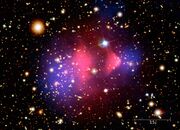Astronomy:Strongly interacting massive particle
Strongly interacting massive particles (SIMPs) are hypothetical particles that interact strongly between themselves and weakly with ordinary matter, but could form the inferred dark matter despite this.[1][2][3]
Strongly interacting massive particles have been proposed as a solution for the ultra-high-energy cosmic-ray problem[4][5] and the absence of cooling flows in galactic clusters.[6][7]
Various experiments and observations have set constraints on SIMP dark matter from 1990 onward.[8][9][10][11][12][13]
SIMP annihilations would produce significant heat. DAMA set limits with NaI(Tl) crystals.[11][citation needed]
Measurements of Uranus's heat excess exclude SIMPs from 150 MeV to 104 GeV.[14] Earth's heat flow significantly constrains any cross section.[15]
See also
- Physics:Weakly interacting massive particles – Hypothetical particles that are thought to constitute dark matter
- Astronomy:Self-interacting dark matter – Hypothetical form of dark matter consisting of particles with strong self-interactions
- Astronomy:Massive compact halo object – Hypothetical form of dark matter in galactic halos
References
- ↑ Wandelt, Benjamin D; Dave, Romeel; Farrar, Glennys R; McGuire, Patrick C; Spergel, David N; Steinhardt, Paul J (2000). "Self-Interacting Dark Matter". in Cline, David B. Sources and Detection of Dark Matter and Dark Energy in the Universe. Springer-Verlag. pp. 263. ISBN 978-3-540-41216-8. Bibcode: 2001sddm.symp..263W.
- ↑ Massey, Richard (2017). "Dark matter dynamics in Abell 3827: new data consistent with standard Cold Dark Matter". Monthly Notices of the Royal Astronomical Society 477 (1): 669–677. doi:10.1093/mnras/sty630. Bibcode: 2018MNRAS.477..669M.
- ↑ Grossman, Lisa (April 5, 2018). "Dark matter isn't interacting with itself after all". ScienceNews. https://www.sciencenews.org/article/dark-matter-isnt-interacting-itself-after-all.
- ↑ Chung, Daniel J. H; Farrar, Glennys R; Kolb, Edward W (1998). "Are ultrahigh energy cosmic rays signals of supersymmetry?". Physical Review D 57 (8): 4606. doi:10.1103/PhysRevD.57.4606. Bibcode: 1998PhRvD..57.4606C.
- ↑ Albuquerque, Ivone F. M; Farrar, Glennys R; Kolb, Edward W (1998). "Exotic massive hadrons and ultra-high energy cosmic rays". Physical Review D 59 (1): 015021. doi:10.1103/PhysRevD.59.015021. Bibcode: 1998PhRvD..59a5021A.
- ↑ Qin, Bo; Wu, Xiang-Ping (2001). "Constraints on the Interaction between Dark Matter and Baryons from Cooling Flow Clusters". Physical Review Letters 87 (6): 061301. doi:10.1103/PhysRevLett.87.061301. PMID 11497819. Bibcode: 2001PhRvL..87f1301Q.
- ↑ Chuzhoy, Leonid; Nusser, Adi (2006). "Consequences of short range interactions between dark matter and protons in galaxy clusters". The Astrophysical Journal 645 (2): 950–954. doi:10.1086/504505. Bibcode: 2006ApJ...645..950C.
- ↑ Starkman, Glenn D; Gould, Andrew; Esmailzadeh, Rahim; Dimopoulos, Savas (1990). "Opening the window on strongly interacting dark matter". Physical Review D 41 (12): 3594–3603. doi:10.1103/PhysRevD.41.3594. PMID 10012303. Bibcode: 1990PhRvD..41.3594S. https://cds.cern.ch/record/212913.
- ↑ Cyburt, Richard H; Fields, Brian D (2002). "Constraining Strong Baryon-Dark Matter Interactions with Primordial Nucleosynthesis and Cosmic Rays". Physical Review D 65 (12): 123503. doi:10.1103/PhysRevD.65.123503. Bibcode: 2002PhRvD..65l3503C..
- ↑ Zaharijas, Gabrijela; Farrar, Glennys R (2004). "A Window in the Dark Matter Exclusion Limits". Physical Review D 72 (8): 083502. doi:10.1103/PhysRevD.72.083502. Bibcode: 2005PhRvD..72h3502Z.
- ↑ 11.0 11.1 Bacci, C. (1996). "Improved limits on strongly interacting massive particles with NaI(Tl) scintillators". Astroparticle Physics 4 (3): 195–198. doi:10.1016/0927-6505(95)00032-1. Bibcode: 1996APh.....4..195B.
- ↑ McGuire, Patrick C; Steinhardt, Paul J (2001). "Cracking Open the Window for Strongly Interacting Massive Particles as the Halo Dark Matter". Proceedings of the International Cosmic Ray Conference. 4. Hamburg, Germany. 1566. Bibcode: 2001ICRC....4.1566M.
- ↑ Javorsek II, D; Fischbach, E; Teplitz, V (2002). "New Experimental Bounds on the Contributions to the Cosmological Density Parameter Ω from Strongly Interacting Massive Particles". The Astrophysical Journal 568 (1): 1–8. doi:10.1086/338796. Bibcode: 2002ApJ...568....1J.
- ↑ Mitra, Saibal (2004). "Uranus's anomalously low excess heat constrains strongly interacting dark matter". Physical Review D 70 (10): 103517. doi:10.1103/PhysRevD.70.103517. Bibcode: 2004PhRvD..70j3517M.
- ↑ Mack, Gregory D; Beacom, John F; Bertone, Gianfranco (2007). "Towards Closing the Window on Strongly Interacting Dark Matter: Far-Reaching Constraints from Earth's Heat Flow". Physical Review D 76 (4): 043523. doi:10.1103/PhysRevD.76.043523. Bibcode: 2007PhRvD..76d3523M.
Further reading
- Bertone, Gianfranco (2010). Particle Dark Matter: Observations, Models and Searches. Cambridge University Press. pp. 762. ISBN 978-0-521-76368-4. Bibcode: 2010pdmo.book.....B.
 |


